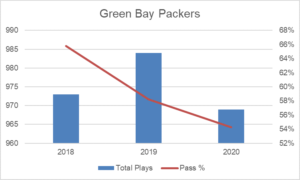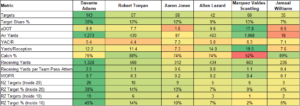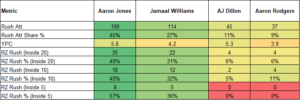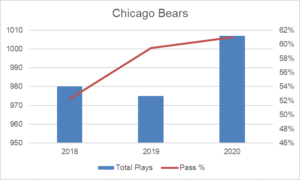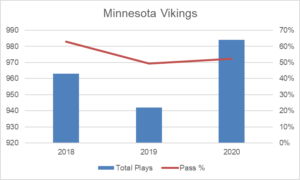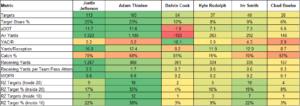NFC North 2020 Team Stats Review
Those who have followed my writing throughout the 2020 season will know that I’m a projections guy, I released weekly content highlighting key facts and stats about play volume, pass/rush tendencies, Vegas lines, target leaders, etc – my Projections Retrospective.
Now that 2020 has drawn to a close, I’ll be spending some time reviewing the total season numbers. The goal, to be more informed about what each team did so we can better project how they’ll tackle 2021 (subject of course to coaching and personnel changes over the offseason).
If you missed it, check out my Projections Guide where I looked at some of the key league-wide numbers for 2020 and stepped through how to create your own projections.
Let’s dive in to the NFC North.
Green Bay Packers
Green Bay have carved out a reputation this year for using every second of the play clock on every play so its unsurprising to see one of the lowest play totals in the league. Despite Rodgers MVP performance, the passing ratio remains low as the Packers benefit from being in the lead more often than not.
This is all about Davante Adams, dominating across the board even with missing essentially three games (without those three games, his target share would have been 37-percent!). MVS almost had as many air yards on less than half the targets, as the aDOT (average depth of target) was twice as big as Adams’, but his catch rate was low (partly due to the aDOT).
In the red zone it was Adams again, followed by Tonyan. Eight of Aaron Jones nine red zone targets (and all four of his targets inside the 10) came in the first three weeks of the season and they only looked for him once as a target after that.
If you remove the two games he missed and the week 16 AJ Dillon game, Aaron Jones had 54-percent of the carries. 46-percent of Jamaal Williams carries came in just three games (two of which Jones missed), and 47-percent of AJ Dillon’s carries came in one game in the snow.
Under the same criteria Jones got 58-percent of red zone carries, and 59-percent of Williams’ carries came in those three games. After the week 5 bye, the Packers only ran the ball four times inside the five yard line for the rest of the season (after running 10 times in the first four games).
Key Takeaway: If a team has not signaled intent in a second receiver then don’t assume there has to be one, especially when you have a player like Adams who can take the burden. This team has success with the ball in Rodgers’ hands so while he’s around, don’t expect them to turn in to the Tennessee Titans with AJ Dillon.
Chicago Bears
Chicago had two different play styles throughout the season, one with Foles under centre and one with Trubisky. With Foles they became one of the most pass-heavy teams in the league, while Trubisky had that level consistently under 60-percent.
Allen Robinson was clearly the dominant receiver but Darnell Mooney was a deep threat with lots of air yards. Robinson had over 100 air yards in four of his first five games but only hit that number once after that, and Mooney had over 100 air yards six times across the season.
Jimmy Graham may be getting old in years but he was still the man inside the red zone. We could be seeing the passing of the tight end torch, especially if Graham is retiring, as Cole Kmet was on a 75 target pace in his last six games. With an improvement in catch rate, Kmet has the opportunity that could quickly turn to production.
At running back, Montgomery’s target pace jumped from 48 to 73 after they lost Cohen to injury, that was huge for his output and wouldn’t have been there had Cohen stayed fit.
Montgomery took a hold of the backfield but absolutely benefited from the Cohen injury. If you look at only the games he played without Cohen, he received 70-percent of the team’s rush attempts. That volume is very much influenced by whoever is under centre, with Trubisky running more himself and also shifting the balance of attack towards the run. I know you can’t remove good games from a running back’s numbers but Montgomery had less than 4 YPC (yards per carry) outside of the two big games against Houston and Green Bay down the stretch.
Key Takeaway: The balance of this team is set to shift dramatically depending on who is taking snaps at Quarterback. Not only does it dictate volume and passing ratio but a better Quarterback will improve the fortunes of a receiving corps who returned sub-par catch percentages and uninspiring YAC/R (yards after catch per reception). The return of Tarik Cohen will be big for Montgomery and I’m buying Kmet while I still can.
Minnesota Vikings
They like to run and they like to dominate the clock, no surprises there. There were a few games where they leant on the pass as they found themselves in high-scoring shootouts, but it’s not their preferred approach. At 11th lowest in total play volume, this was simple regression from an excessively low total in 2019.
On first review we can see a similar level of targets for both Jefferson and Thielen, with Jefferson creeping away on production with slightly more air yards but much better YAC (yards after catch) than his colleague (Thielen did miss one game so would have slightly bettered Jefferson on the target front). We all know about Jefferson’s historic rookie season but those target numbers aren’t alpha-receiver levels and it’s still a tandem attack, relying on the high-efficiency plays to make up for the reduced volume (similar to AJ Brown). This team is all about tandems and pairs with Kyle Rudolph and Irv Smith sharing that next role almost evenly across every aspect.
There’s really not much to look at in the running game, it’s Dalvin Cook with a bit of Dalvin Cook and a splash of Dalvin Cook to finish it off. Mattison does a great job of giving him a rest but that’s about it.
Key Takeaway: This team has a clear and predictable identity. High volume of running plays, and a concentrated passing attack relying on high efficiency plays. While Kyle Rudolph is around, Irv Smith isn’t going to be a big thing for fantasy.
Detroit Lions
A slight dip in volume but nothing too crazy. They were on the lower end of the volume scale already and found themselves even lower in 2020. The passing ratio only dropped below 60-percent twice in the last 11 games having only gone above once in the first five.
Marvin Jones was a clear beneficiary of Kenny Golladay’s injury, getting 14-percent of targets when Golladay played and 22-percent when he didn’t. They tried out the rookie Cephus in the first game with 10 targets but clearly weren’t impressed, only giving him more than three targets once after that. Hockenson was the next man up, getting a shorter aDOT (average depth of target) but much better YAC (yards after catch) than Jones.
Adrian Peterson continues to be a thorn of the side of any rookie running back who finds himself on the same team, although a hell of a mentor to learn from. Peterson had the market share at the start of the season and again when Swift got injured but outside of those missed games, you can see the shift to Swift as the season went on, including in the red zone.




